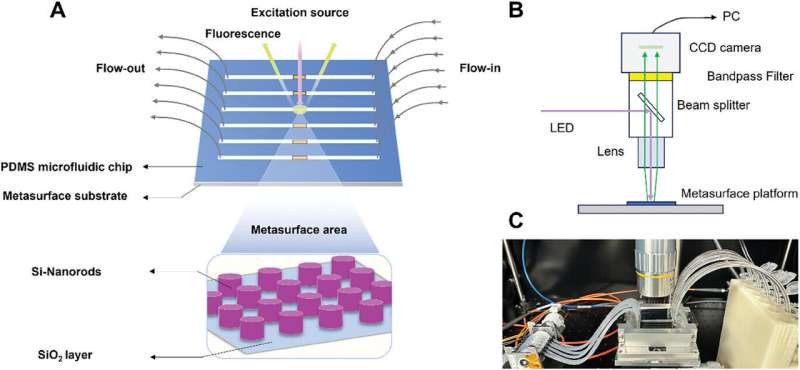This article has been reviewed according to Science X's editorial process and policies. Editors have highlighted the following attributes while ensuring the content's credibility:
fact-checked
peer-reviewed publication
trusted source
proofread
New platform integrates microfluidics and metasurface for kidney disease testing

Development of a new way to accurately measure human serum albumin (HSA) levels in people with chronic kidney disease has progressed in recent testing by Flinders University and Japanese researchers.
Further engineering of the novel system of aggregation induced emissions (AIE) biosensors, pioneered at Flinders University, was conduced by Ph.D. candidate Qi Hu in Japan as part of a National Institute for Materials Science (NIMS) Cooperative Graduate Program, with Dr. Masanobu Iwanaga, an expert on metasurface in optical biosensing.
The research project combines fluorescent (FL) biosensors with AIE with further engineering of a novel metasurface platform to improve readings of HSA in urine tests.
The article, "Metasurface platform incorporating aggregation induced emission based biosensor for enhanced human serum albumin detection" has been published in the journal Advanced Optical Materials.
"In our collaboration with experts at the National Institute for Materials Science in Japan, we sought to overcome some of the vagaries in readings from testing urine samples for HSA using this promising new field of fluorescent biosensors," explains Professor Youhong Tang, from the Medical Device Research Institute and Flinders Institute for NanoScale Science and Technology, College of Science and Engineering.
"The novel nanophotonic all-dielectric metasurface platform incorporated with AIE biosensors has been fabricated to achieve extraordinary HSA detection performance," says Professor Tang, adding that it has potential for testing diabetic kidney disease and acute kidney injury.
More accurate, portable and affordable testing can make large-scale surveys of biomarkers of kidney function more accessible—including in remote or areas with basic health facilities—with chronic kidney disease under-reported in the population because it is often asymptomatic, researchers say.
Chronic kidney disease (CKD) is on the rise around the globe due to aging populations, with more than 1.7 million Australians or about 11% of the adult population living with the condition. Accurate estimates of the prevalence of CKD require large-scale surveys of biomarkers of kidney function in the population.
Biomarker diagnosis can be difficult as the kidneys are still able to function adequately when they are slightly damaged. Low levels of HSA are important indicators to monitor the status or progression of the condition in existing CKD and diabetic kidney disease (DKD) patients. Accurate estimates of the prevalence of all three kidney conditions require large-scale surveys of biomarkers of kidney function in the population.
As some diagnoses require the presence of measured biomarkers that persist for at least three months, people often do not realize they have the disease which can lead to long-term health problems.
Mr. Hu says the new platform "integrates a microfluidic system and a metasurface substrate to enable analyte delivery and the monitoring/detecting AIE FL enhancement in real time with the outstanding characteristics of high throughput, good reusability and low reagent consumption."
Dr. Iwanaga, Group Leader of Nanophotonics Group, Research Center for Electronic and Optical Materials at NIMS in Japan, says, "As well, this proposed metasurface can service as a biomedical chip-based platform for providing a promising pathway of enhancing sensing and biomarker detection quantitatively."
More information: Qi Hu et al, Metasurface Platform Incorporating Aggregation Induced Emission Based Biosensor for Enhanced Human Serum Albumin Detection, Advanced Optical Materials (2024). DOI: 10.1002/adom.202400868
Journal information: Advanced Optical Materials
Provided by Flinders University




















